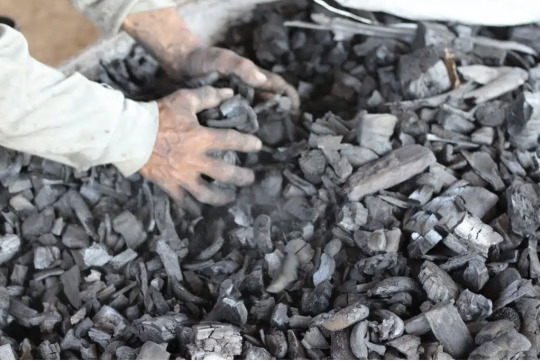#biochar market Growth
Explore tagged Tumblr posts
Text
Biochar Market Analysis: Growth Trends and Opportunities Through 2031
Biochar Market Analysis: Growth Trends and Opportunities Through 2031
The global biochar market is experiencing remarkable growth as industries and agricultural sectors increasingly recognize its benefits in soil enhancement, carbon sequestration, and sustainable waste management. Biochar, a stable form of carbon produced from biomass pyrolysis, is emerging as a key player in mitigating climate change and promoting circular economy practices. Here's an in-depth look at the market's insights, segmentation, dynamics, regional trends, and emerging opportunities.
Market Insights: The Growing Demand for Biochar
Biochar's multifunctional benefits, such as improving soil fertility, reducing greenhouse gas emissions, and enhancing water retention, are driving its demand across various applications. Its increasing adoption in agriculture, horticulture, and waste management aligns with global sustainability goals. Moreover, the rising focus on renewable energy sources and carbon offset mechanisms is further propelling the market's growth.
Segmental Analysis: Biochar Applications and Feedstocks
The biochar market is segmented based on applications, technology, and feedstock sources:
Applications:
Agriculture: Biochar enhances soil quality, promotes crop yield, and reduces the need for chemical fertilizers.
Animal Husbandry: It is used as an additive in animal feed and bedding, improving livestock health.
Environmental Management: Biochar is applied for wastewater treatment, carbon sequestration, and air purification.
Technology:
Pyrolysis: The most common method for biochar production, known for its efficiency and scalability.
Gasification and Hydrothermal Carbonization: Emerging technologies focusing on improving yield and energy recovery.
Feedstock:
Biochar production utilizes agricultural residues, forestry waste, and organic municipal waste, making it an eco-friendly and cost-effective solution.
Market Dynamics: Drivers, Challenges, and Opportunities
The biochar market's growth is influenced by a mix of driving factors, challenges, and opportunities:
Market Drivers:
The increasing global focus on sustainable agriculture and soil health is a significant growth driver.
Government incentives and carbon credit mechanisms support biochar adoption as a tool for carbon sequestration.
Challenges:
High production costs and limited awareness among end-users can hinder market growth.
The lack of standardized quality parameters for biochar remains a challenge for widespread adoption.
Opportunities:
Advancements in biochar production technologies promise cost reductions and increased efficiency.
Expanding applications in construction and energy storage present new growth avenues.
Regional Insights: Global Market Distribution
The biochar market showcases distinct growth patterns across regions:
North America:
The region leads in biochar adoption, driven by advancements in sustainable farming practices and favorable government policies.
The U.S. dominates the market, emphasizing large-scale carbon offset initiatives.
Europe:
Stringent environmental regulations and a strong emphasis on climate action bolster the demand for biochar in this region.
Countries like Germany and the UK are focusing on biochar for soil remediation and renewable energy projects.
Asia-Pacific:
The rapid industrialization and agricultural expansion in nations like China, India, and Japan drive market growth.
The region also benefits from abundant feedstock availability and increasing awareness of sustainable farming techniques.
Latin America and Africa:
Emerging economies in these regions are adopting biochar for agricultural productivity and waste management.
Favorable climatic conditions and agricultural practices further support biochar utilization.
Key Market Trends: Innovations and Sustainability
Focus on Carbon Sequestration: The role of biochar in reducing atmospheric carbon levels and offsetting emissions is a growing area of focus globally.
Expansion into New Applications: Innovative uses of biochar in energy storage, construction materials, and environmental remediation are expanding its market potential.
Technological Advancements: Innovations in pyrolysis and hybrid production techniques are improving the scalability and cost-effectiveness of biochar production.
Circular Economy Practices: The integration of biochar into waste-to-energy and biomass management projects aligns with the global push for sustainable resource utilization.
Biochar’s Role in a Sustainable Future
The biochar market is poised for significant growth, driven by its expanding applications in agriculture, environmental management, and beyond. While challenges like high production costs persist, technological advancements and increasing awareness of its benefits are creating promising opportunities. As industries and governments work towards sustainability goals, biochar is set to play a pivotal role in shaping a greener and more resilient future.
#biochar market#biochar market Size#biochar market Share#biochar market Trends#biochar market Growth#biochar market Outlook#biochar market Key Players#biochar market Overview#biochar market Competitor#biochar market Insights#biochar market Forecast#biochar market Analysis#biochar market Statistics#biochar market Innovations
0 notes
Text
Biochar Market Likely To Reach Beyond $1350 Million By 2030
The global biochar market size is expected to reach USD 1350 million by 2030, registering a CAGR of 13.9% from 2024 to 2030, according to a new report by Grand View Research, Inc. Globally increasing demand for the product in organic farming has been a major factor influencing the growth. In addition, increasing consumption in livestock feed and awareness pertaining to benefits of biochar as soil amendment are expected to drive the demand.
Biochar is an evolving industry and is anticipated to become a major influencing factor in increased crop yield and productivity of the agriculture sector. It improves soil fertility and provides necessary nutrition to crop. Moreover, applications in energy production and greenhouse gas remediation are expected to provide new revenue opportunities to the sector.
The market consists of organized and unorganized manufacturers. Growing economies such as China, India, Japan, Mexico, and Brazil produce significant amount of biochar through small and medium scale industries mainly running into village areas. Whereas, large scale manufacturers are concentrated in North America.
Consumption in agricultural application was the highest in 2022 and is anticipated to rise significantly over the forecast period. Among various applications in agriculture, farming held the highest market share in 2022.
In terms of volume, the agriculture sector is estimated to witness speedy growth over the forecast period. It has also gained high popularity in livestock farming as an additive in animal feed. The livestock sector has gained high importance, especially in regions such as Europe and North America where animal flesh is extensively consumed by human beings as a food. As a result of this, biochar consumption is expected to grow substantially in the foreseeable future.

Request a free sample copy or view report summary: Biochar Market Report
Biochar Market Report Highlights
Total product manufactured using pyrolysis technology in 2023 accounted for 65.1% market share in terms of revenue and is expected witness rapid growth over the estimated period
Asia Pacific is expected to witness extensive growth in the forthcoming years due to increasing application of the product in livestock feed and organic farming
Pyrolysis technology is increasingly used by Earth Systems and Clean Fuels B.V. among other manufacturers operating in the biochar market.
Biochar Market Segmentation
Grand View Research has segmented the global biochar market based on technology, application, and region:
Biochar Technology Outlook (Volume, Kilotons; Revenue, USD Million, 2018 - 2030)
Pyrolysis
Gasification
Others
Biochar Application Outlook (Volume, Kilotons; Revenue, USD Million, 2018 - 2030)
Agriculture
Animal Farming
Industrial Uses
Other Applications
Biochar Regional Outlook (Volume, Kilotons; Revenue, USD Million, 2018 - 2030)
North America
U.S.
Canada
Mexico
Europe
Germany
UK
France
Sweden
Denmark
Asia Pacific
China
India
Japan
Australia
Malaysia
Central & South America
Middle East & Africa
List of Key Players in Biochar Market
Biochar Products, Inc.
Biochar Supreme, LLC
ArSta Eco
Carbon Gold Ltd
Airex Energy Inc.
Pacific Biochar Benefit Corporation
Contact Us: - https://www.grandviewresearch.com/horizon
#Biochar Market#Biochar Market Analysis#Biochar Market Forecast#Biochar Market Share#Biochar Market Growth#Biochar Market Research#Biochar Market Trends#Biochar Market Size#Biochar Market Outlook
0 notes
Text
#Biochar Market#Biochar Market Size#Biochar Market Growth#Biochar Market Trends#Biochar Market Opportunities#Biochar Market Analysis
0 notes
Text
Asia Pacific Biochar Market Size Is Expanding Around USD XX Mn By 2028
The Asia Pacific Biochar Market is witnessing significant growth, driven by rising demand for sustainable agricultural solutions, soil health improvement, and carbon sequestration practices. With increasing environmental concerns and government initiatives promoting sustainable farming practices, the biochar market is set to expand rapidly across the region through 2028.
📊 Asia Pacific Biochar Market Overview and Size
The Asia Pacific Biochar Market was valued at USD 576 million in 2023 and is projected to grow at a CAGR of xx % from 2023 to 2028. The growing need for soil improvement, crop productivity enhancement, and waste management is driving demand for biochar across the region. Additionally, biochar is gaining popularity due to its role in carbon capture, aligning with global climate action goals.
Key countries like China, India, Japan, and Australia are leading the adoption of biochar in agricultural and environmental sectors, with applications spanning from soil remediation to water treatment.

🚀 Key Market Statistics and Trends
✅ China and India collectively account for over 60% of the Asia Pacific biochar market, driven by large-scale agricultural activities.
✅ Sustainable agriculture practices are on the rise, with farmers and governments seeking alternatives to chemical fertilizers.
✅ Carbon trading programs in countries like Japan and Australia are incentivizing biochar adoption for its carbon sequestration benefits.
Click on the Link to Download the Sample Report
🌱 Growth Drivers of the Asia Pacific Biochar Market
Soil Health Improvement
Biochar enhances soil fertility, retains moisture, and reduces the need for chemical fertilizers, making it a preferred choice for sustainable agriculture.
Carbon Sequestration Initiatives
Biochar’s ability to capture and store carbon in the soil aligns with climate action goals, promoting its usage across the region.
Waste Management Solutions The production of biochar from organic waste and biomass provides an efficient way to manage agricultural residues and reduce waste.
Government Initiatives and Incentives
Governments across Asia Pacific are implementing policies to encourage sustainable farming practices, including the use of biochar for soil remediation and environmental protection.
🛠️ Asia Pacific Biochar Market Segmentation and Trends
By Application:
Agriculture: Biochar is primarily used to improve soil fertility and crop productivity.
Waste Management: Biochar production from organic waste is gaining traction as a sustainable solution.
Water Treatment: Biochar is being utilized to filter and purify water due to its adsorption properties.
By Feedstock:
Wood Waste: Dominates the biochar market, accounting for a significant share due to its widespread availability.
Agricultural Waste: The use of crop residues and biomass to produce biochar is increasing rapidly.
Animal Manure: Emerging as a feedstock option for producing biochar in livestock farming regions.
By Region:
China: Leading the market due to large-scale agricultural activities and government incentives for carbon reduction.
India: Showing rapid adoption of biochar in sustainable farming practices to address soil degradation.
Australia: Prominent in biochar research and carbon sequestration programs.
🌍 Emerging Trends in the Asia Pacific Biochar Market
Carbon Trading Programs Countries like Japan and Australia are incorporating biochar into their carbon trading systems, offering financial incentives for carbon capture.
Innovation in Biochar Production New technologies are being developed to produce biochar more efficiently and sustainably from various feedstocks.
Eco-Friendly Farming Solutions Farmers are increasingly adopting biochar as part of their sustainable farming practices to reduce reliance on chemical inputs.
Growing Focus on Climate Resilience With rising concerns about climate change, biochar is being recognized for its ability to improve soil health and help mitigate climate impacts on agriculture.
⚠️ Challenges to Watch in the Asia Pacific Biochar Market
High Production Costs The cost of biochar production remains a significant challenge, particularly for small-scale farmers.
Lack of Awareness Many farmers and stakeholders in the agricultural sector are still unaware of the long-term benefits of biochar.
Regulatory Barriers The absence of standardized regulations across the region can hinder the adoption of biochar in some countries.
🛤️ Asia Pacific Biochar Market Outlook to 2028
The Asia Pacific Biochar Market is expected to experience robust growth over the next five years, driven by sustainable agricultural practices, carbon capture initiatives, and innovations in biochar production technologies.
Future Projections for the Biochar Market: 📈 The market is projected to grow at a CAGR of xx% from 2023 to 2028. 🌱 Sustainable farming practices will continue to drive biochar adoption, particularly in China, India, and Australia. 🌍 Carbon trading programs and government incentives will further support market growth across the region.
🏢 Competitive Landscape in the Asia Pacific Biochar Market
Key players in Asia Pacific biochar market include:
Pacific Biochar
ECOERA AB
Carbon Gold Ltd.
Biochar Now
Agri-Tech Producers, LLC
Key Competitor Strategies:
✅ Product Innovation: Companies are investing in new biochar production technologies to reduce costs and improve efficiency.
✅ Sustainability Initiatives: Major players are focusing on the environmental benefits of biochar to attract eco-conscious customers.
✅ Partnerships and Collaborations: Firms are collaborating with governments and research institutions to promote biochar adoption.
💡 Final Thought
The Asia Pacific Biochar Market is at the forefront of sustainable agriculture and climate action initiatives. With increasing awareness of biochar’s benefits and growing government support, the market is poised for transformative growth through 2028.
#Asia Pacific Biochar Market#Asia Pacific Biochar Industry#Asia Pacific Biochar Sector#Asia Pacific Biochar Market Size#Asia Pacific Biochar Market Share#Asia Pacific Biochar Market Revenue#Asia Pacific Biochar Market Growth Rate
0 notes
Text
#Biochar Fertilizer Market Size#Biochar Fertilizer Market Share#Biochar Fertilizer Market Growth#Biochar Fertilizer Market Trends#Biochar Fertilizer Market Forecast Analysis#Biochar Fertilizer Market Segmentation#Biochar Fertilizer Market 2024#Biochar Fertilizer Market CAGR#Biochar Fertilizer Market Analyzer Industry
0 notes
Text

#Biochar Fertilizer Market#Biochar Fertilizer Size#Biochar Fertilizer Growth#Biochar Fertilizer Trend#Biochar Fertilizer segment#Biochar Fertilizer Opportunity#Biochar Fertilizer Analysis 2024#Biochar Fertilizer Forecast
0 notes
Text
Biochar Fertilizer Market Expected to Witness High Growth over the Forecast Period 2022-2029

#Biochar Fertilizer Market#Biochar Fertilizer Market trend#Biochar Fertilizer Market size#Biochar Fertilizer Market growth
0 notes
Text
Good News - April 1-7
Like these weekly compilations? Support me on Ko-fi! Also, if you tip me on here or Ko-fi, at the end of the month I’ll send you a link to all of the articles I found but didn’t use each week - almost double the content! (I’m new to taking tips on here; if it doesn’t show me your username or if you have DM’s turned off, please send me a screenshot of your payment)
1. Three Endangered Asiatic Lion Cubs Born at London Zoo

“The three cubs are a huge boost to the conservation breeding programme for Asiatic lions, which are now found only in the Gir Forest in Gujarat, India.”
2. United Nations Passes Groundbreaking Intersex Rights Resolution

“The United Nations Human Rights Council has passed its first ever resolution affirming the rights of intersex people, signaling growing international resolve to address rights violations experienced by people born with variations in their sex characteristics.”
3. Proposal to delist Roanoke logperch

“Based on a review of the best available science, the U.S. Fish and Wildlife Service (Service) has determined that the Roanoke logperch, a large freshwater darter, is no longer at risk of extinction. […] When the Roanoke logperch was listed as endangered in 1989, it was found in only 14 streams. In the years since, Roanoke logperch surveys and habitat restoration have more than doubled the species range, with 31 occupied streams as of 2019.”
4. Fully-Accessible Theme Park Reopens Following Major Expansion

“Following the $6.5 million overhaul, the park now offers [among other “ultra-accessible” attractions] a first-of-its-kind 4-seat zip line that can accommodate riders in wheelchairs as well as those who need extra restraints, respiratory equipment or other special gear.”
5. ‘The Javan tiger still exists’: DNA find may herald an extinct species’ comeback

“A single strand of hair recovered from [a sighting] is a close genetic match to hair from a Javan tiger pelt from 1930 kept at a museum, [a new] study shows. “Through this research, we have determined that the Javan tiger still exists in the wild,” says Wirdateti, a government researcher and lead author of the study.”
6. Treehouse Village: Eco-housing and energy savings

““The entire place is designed and built to meet the passive house standard, which is the most energy-efficient construction standard in the world,” says resident Wayne Groszko, co-owner of one of the units at Treehouse.”
7. 50 rare crocodiles released in Cambodia's tropical Cardamom Mountains

“Cambodian conservationists have released 50 captive-bred juvenile Siamese crocodiles at a remote site in Cambodia as part of an ongoing programme to save the species from extinction.”
8. The Remarkable Growth of the Global Biochar Market: A Beacon of Environmental Progress

“Biochar, a stable carbon form derived from organic materials like agricultural residues and forestry trimmings, is a pivotal solution in the fight against global warming. By capturing carbon in a stable form during biochar production, and with high technology readiness levels, biochar offers accessible and durable carbon dioxide removal.”
9. 'Seismic' changes set for [grouse shooting] industry as new Scottish law aims to tackle raptor persecution

“Conservation scientists and campaigners believe that birds such as golden eagles and hen harriers are being killed to prevent them from preying on red grouse, the main target species of the shooting industry. […] Under the Wildlife Management and Muirburn Bill, the Scottish grouse industry will be regulated for the first time in its history.”
10. White House Awards $20 Billion to Nation’s First ‘Green Bank’ Network

“At least 70 percent of the funds will go to disadvantaged communities, the administration said, while 20 percent will go to rural communities and more than 5 percent will go to tribal communities. […] The White House said that the new initiative will generate about $150 billion in clean energy and climate investments[…].”
March 22-28 news here | (all credit for images and written material can be found at the source linked; I don’t claim credit for anything but curating.)
#hopepunk#good news#lion#conservation#zoo#india#intersex#lgbt rights#human rights#fish#endangered#disability#accessibility#amusement park#tiger#big cats#extinction#extinct species#ecofriendly#affordable housing#energy efficiency#crocodiles#global warming#climate change#scotland#raptor#eagles#hunting#solar panels#solar energy
9 notes
·
View notes
Text
Lay Lele Lay Lele Mazza !!!

Burning crop residues, such as crop stubble or straw, by Indian farmers can have several negative side effects, both environmentally and health-wise. This practice, known as crop residue burning, is often done as a quick and cost-effective way to prepare fields for the next planting season. To tackle this problem Leo Burnett collaborated with Lay’s and launched “The Biochar Project.” This innovative technology could help millions of Indian Farmers cut down the pollution by 50% and other cost-saving benefits, but due to their rigidness towards traditional methods and the major issue of penetrating into a market that in majority is uneducated has been a substantial Hindrance in the growth of this project.
Task at hand- You are the CMO of “The Biochar Project” and have been asked to visit the target audience and create awareness about the project.
Deliverables-
Detailed report on the project catering to the target audience (include the technical aspect of the process)
Facebook, radio, newspaper campaign
Phase Wise implementation plan
Project’s budget sheet
4 notes
·
View notes
Text
Biochar Market Analysis, Size, Share, Growth, Trends, and Forecasts by 2031

The Global Biochar market is a burgeoning sector within the broader agricultural and environmental industry, poised to revolutionize traditional farming practices and contribute significantly to sustainable land management. Biochar, a carbon-rich material derived from the pyrolysis of biomass, holds immense promise as a soil amendment, carbon sequestration tool, and renewable energy source.
𝐆𝐞𝐭 𝐚 𝐅𝐫𝐞𝐞 𝐒𝐚𝐦𝐩𝐥𝐞 𝐑𝐞𝐩𝐨𝐫𝐭:https://www.metastatinsight.com/request-sample/2728
Top Companies
Black Owl Biochar
NextChar
Terra Char
Genesis Industries
CharGrow
Biochar Now
Soil Reef
BioChar6
Pacific Biochar Corporation
Airex Energy Inc.
ArSta Eco
Biochar Solutions Inc
Carbon Gold Ltd
Farm2Energy Pvt Ltd
Phoenix Energy
As the world grapples with the challenges of climate change, soil degradation, and food security, the demand for biochar is expected to soar, driving innovation and investment in this dynamic market.
𝐄𝐱𝐩𝐥𝐨𝐫𝐞 𝐭𝐡𝐞 𝐅𝐮𝐥𝐥 𝐑𝐞𝐩𝐨𝐫𝐭:@https://www.metastatinsight.com/report/biochar-market
The biochar industry encompasses a diverse range of stakeholders, including biochar producers, agricultural enterprises, environmental organizations, research institutions, and policymakers. These players collaborate to explore the multifaceted applications of biochar and unlock its full potential for mitigating climate change and enhancing agricultural productivity. From small-scale biochar producers utilizing locally sourced feedstock to large corporations investing in state-of-the-art pyrolysis technology, the market is characterized by a spectrum of approaches tailored to specific regional contexts and market demands.
One of the key drivers propelling the growth of the Global Biochar market is increasing awareness of the environmental benefits of biochar application. As consumers become more conscious of the carbon footprint associated with conventional farming practices, there is a growing demand for sustainable alternatives that promote soil health and reduce greenhouse gas emissions. Biochar, with its ability to enhance soil fertility, retain moisture, and sequester carbon in the soil for centuries, is increasingly recognized as a viable solution to address these challenges.
Furthermore, advances in biochar production technologies and process optimization are anticipated to drive market expansion in the coming years. From innovative pyrolysis reactors capable of producing high-quality biochar at scale to integrated bioenergy systems that maximize resource efficiency, technological innovation is reshaping the biochar industry landscape. As research continues to elucidate the complex interactions between biochar, soil microbiology, and plant physiology, new opportunities for product development and market growth are expected to emerge.
The Global Biochar market is poised for exponential growth as stakeholders across the agricultural and environmental sectors recognize the transformative potential of biochar in addressing pressing global challenges. With increasing awareness, technological innovation, and supportive policy frameworks, biochar is poised to emerge as a cornerstone of sustainable land management practices in the decades to come.
Global Biochar market is estimated to reach $505.1 Million by 2031; growing at a CAGR of 11.2% from 2024 to 2031.
Contact Us:
+1 214 613 5758
#Biochar#Biocharmarket#Biocharindustry#marketsize#marketgrowth#marketforecast#marketanalysis#marketdemand#marketreport#marketresearch
0 notes
Text
Biochar Market Insights and Opportunities for Sustainable Agriculture
The biochar market is rapidly expanding, driven by an increasing awareness of its environmental benefits and growing demand for sustainable practices in agriculture, waste management, and energy production. As the world faces climate change challenges, biochar offers significant potential for reducing carbon emissions, improving soil health, and addressing waste disposal issues. This market has witnessed significant investments and innovation in recent years, with many industries looking to capitalize on biochar's versatility. In this article, we explore the key insights into the biochar market, including growth drivers, regional trends, challenges, and future prospects.

Growth Drivers
Sustainability Trends: As global agricultural practices shift toward sustainability, biochar is becoming increasingly valued for its ability to enhance soil fertility and reduce dependency on chemical fertilizers. The growing focus on sustainable farming methods is driving the demand for biochar, which helps improve water retention, soil structure, and nutrient availability.
Carbon Sequestration: Biochar offers a long-term solution for carbon sequestration. Its ability to store carbon for hundreds to thousands of years makes it an essential tool in climate change mitigation efforts. Governments and industries are adopting biochar technologies to reduce carbon footprints and enhance their environmental credentials.
Waste-to-Value Concept: With a rising focus on waste management, biochar is seen as an efficient way to recycle organic waste. Agricultural residues, forest biomass, and municipal solid waste can be converted into biochar, effectively addressing waste disposal issues while providing an eco-friendly solution for various sectors.
Market Segmentation
By Feedstock Type: The biochar market is segmented based on feedstock types, with wood, agricultural waste, and other biomass being the primary materials used in biochar production. Agricultural waste, in particular, is gaining attention as it provides an abundant and cost-effective source of feedstock for biochar production.
By Application: The major applications of biochar include agriculture, water filtration, carbon sequestration, and renewable energy. In agriculture, biochar is utilized for soil improvement and as an additive in fertilizers. In the energy sector, it is increasingly used as a sustainable energy source due to the syngas and bio-oil produced during its production process.
By Region: The biochar market is growing across various regions, with North America, Europe, and Asia Pacific leading the market share. North America, in particular, is witnessing significant adoption of biochar due to its strong regulatory support and the growing demand for sustainable agricultural practices. The Asia-Pacific region is also showing promising growth due to the rising demand for effective waste management solutions.
Key Market Trends
Technological Advancements: Advances in pyrolysis technology are improving the efficiency and scalability of biochar production. Emerging technologies focus on lowering production costs, enhancing feedstock versatility, and increasing biochar yields. This is expected to make biochar production more economically viable and accessible for a broader range of industries.
Government Policies and Incentives: Regulatory support plays a crucial role in the biochar market's growth. Governments are implementing policies to encourage sustainable practices, including the use of biochar for carbon sequestration and soil health improvement. Incentives, grants, and funding programs are expected to further drive adoption, particularly in developing countries.
Corporate Partnerships and Investments: Major companies are forming partnerships and making investments to promote biochar technologies. These collaborations aim to scale up biochar production, develop new applications, and bring innovative solutions to market. Private sector involvement is expected to further accelerate the growth of the biochar industry.
Challenges and Barriers
High Production Costs: One of the main challenges faced by the biochar market is the high initial capital required to set up pyrolysis plants. The cost of raw materials, energy consumption, and the complexity of production processes make biochar production expensive. Lowering production costs through technological innovation will be key to making biochar more accessible and cost-competitive.
Awareness and Education: While the benefits of biochar are widely recognized, there is still a lack of widespread understanding, especially in regions where biochar's applications are not well-known. Educating farmers, businesses, and policymakers about biochar’s advantages and practical uses is essential for market growth.
Regulatory Hurdles: The biochar industry faces challenges related to varying regulations across different regions. Harmonizing standards for production, quality control, and certification of biochar is necessary to foster industry growth and ensure its safe use in agriculture and other sectors.
Future Outlook
Market Growth: The biochar market is expected to experience steady growth in the coming years, driven by the rising demand for sustainable solutions in agriculture, waste management, and carbon offset programs. Biochar’s ability to enhance soil quality, mitigate climate change, and offer renewable energy solutions positions it as a key component of sustainable development.
Technological Developments: Ongoing advancements in pyrolysis technology, as well as innovations in feedstock management and biochar applications, will continue to shape the future of the biochar market. As production processes become more efficient and cost-effective, biochar will become an even more attractive solution for industries worldwide.
In conclusion, the biochar market is poised for significant expansion due to its versatility in addressing environmental challenges and contributing to sustainable practices. The combination of government support, technological advancements, and growing awareness is expected to drive the market forward, making biochar an essential tool in creating a more sustainable and carbon-conscious future.
0 notes
Text
0 notes
Text
The Biochar Revolution: Unlocking Potential in Agriculture and Beyond
The global biochar market size is expected to reach USD 1350 million by 2030, registering a CAGR of 13.9% from 2024 to 2030, according to a new report by Grand View Research, Inc. Globally increasing demand for the product in organic farming has been a major factor influencing the growth. In addition, increasing consumption in livestock feed and awareness pertaining to benefits of biochar as soil amendment are expected to drive the demand.
Biochar is an evolving industry and is anticipated to become a major influencing factor in increased crop yield and productivity of the agriculture sector. It improves soil fertility and provides necessary nutrition to crop. Moreover, applications in energy production and greenhouse gas remediation are expected to provide new revenue opportunities to the sector.
The market consists of organized and unorganized manufacturers. Growing economies such as China, India, Japan, Mexico, and Brazil produce significant amount of biochar through small and medium scale industries mainly running into village areas. Whereas, large scale manufacturers are concentrated in North America. Consumption in agricultural application was the highest in 2022 and is anticipated to rise significantly over the forecast period. Among various applications in agriculture, farming held the highest market share in 2022.
In terms of volume, the agriculture sector is estimated to witness speedy growth over the forecast period. It has also gained high popularity in livestock farming as an additive in animal feed. The livestock sector has gained high importance, especially in regions such as Europe and North America where animal flesh is extensively consumed by human beings as a food. As a result of this, biochar consumption is expected to grow substantially in the foreseeable future.
Biochar Market Report Highlights
Total product manufactured using pyrolysis technology in 2023 accounted for 65.1% market share in terms of revenue and is expected witness rapid growth over the estimated period
Asia Pacific is expected to witness extensive growth in the forthcoming years due to increasing application of the product in livestock feed and organic farming
Pyrolysis technology is increasingly used by Earth Systems and Clean Fuels B.V. among other manufacturers operating in the biochar market.
Biochar Market Segmentation
Grand View Research has segmented the global biochar market based on technology, application, and region:
Biochar Technology Outlook (Volume, Kilotons; Revenue, USD Million, 2018 - 2030)
Pyrolysis
Gasification
Others
Biochar Application Outlook (Volume, Kilotons; Revenue, USD Million, 2018 - 2030)
Agriculture
Animal Farming
Industrial Uses
Other Applications
Biochar Regional Outlook (Volume, Kilotons; Revenue, USD Million, 2018 - 2030)
North America
US
Canada
Mexico
Europe
Germany
UK
France
Sweden
Denmark
Asia Pacific
China
India
Japan
Australia
Malaysia
Central & South America
Middle East & Africa
List of Key Players in Biochar Market
Biochar Products, Inc.
Biochar Supreme, LLC
ArSta Eco
Carbon Gold Ltd
Airex Energy Inc.
Pacific Biochar Benefit Corporation
Order a free sample PDF of the Biochar Market Intelligence Study, published by Grand View Research.
0 notes
Text
Biochar Market Analysis, Trends and Dynamic Demand by Forecast 2024 to 2034

The Biochar market is witnessing significant growth driven by its increasing use in agriculture, waste management, and environmental applications. Biochar is a carbon-rich, fine-grained substance obtained through the thermal decomposition of organic materials under limited oxygen conditions (pyrolysis). It offers multiple benefits, such as improving soil fertility, enhancing crop yield, reducing greenhouse gas emissions, and sequestering carbon.
The global biochar market is expected to reach USD 3,429.58 million in 2034, based on an average growth pattern, and the report projects that the market will grow at a compound annual growth rate (CAGR) of 16.2% from 2024 to 2034. Revenue from the global biochar market is projected to reach USD 758.36 million by 2024.
Get a sample copy of this report: https://wemarketresearch.com/reports/request-free-sample-pdf/biochar-market/1613
Biochar Market Drivers
Growing Demand for Soil Amendment Biochar's ability to improve soil health by enhancing nutrient retention and water holding capacity is driving its adoption in the agriculture sector.
Sustainability and Carbon Sequestration Initiatives Governments and organizations are promoting biochar production due to its potential in combating climate change by sequestering atmospheric carbon.
Rising Waste Management Concerns Biochar production offers a sustainable solution for converting agricultural and organic waste into a value-added product, reducing waste management challenges.
Increased Focus on Organic Farming The shift towards organic farming practices has increased the demand for biochar as a natural soil enhancer, free of synthetic additives.
Trends in the Biochar Market
Integration with Bioenergy Production Companies are increasingly integrating biochar production with bioenergy systems, using waste heat from pyrolysis to generate renewable energy.
Biochar for Urban Green Spaces Cities are exploring biochar’s use in improving urban green spaces, gardens, and landscaping, promoting sustainable urban development.
Use in Livestock and Poultry Farming Biochar is gaining traction as a feed additive for livestock and poultry, improving digestion and reducing methane emissions from ruminants.
Waste-to-Resource Models Municipalities are adopting waste-to-resource models where organic waste from cities is converted into biochar, reducing landfill waste and creating a circular economy.
Advanced Biochar Blends Some companies are developing specialized biochar blends with additional nutrients or microbial inoculants to enhance its agricultural performance.
Biochar Market Opportunities
Carbon Credit Markets With the rise of carbon credit trading, biochar producers can benefit from selling carbon credits to industries aiming to offset their carbon emissions.
Agritech Innovations Startups focusing on agritech and sustainable farming are exploring partnerships with biochar producers to develop innovative soil enhancement products.
Research and Development Universities and research institutions are actively investing in biochar research to explore new applications, such as biochar-based fertilizers and bioplastics.
Advancements in Biochar Production
Automated Pyrolysis Units Automated systems for biochar production are being developed to improve efficiency, reduce costs, and enhance scalability.
AI-Powered Process Optimization Companies are integrating AI and IoT technologies into biochar production to monitor and optimize the pyrolysis process for better yield and quality.
Biochar-Nano Composites Advanced research is being conducted on biochar-based nanocomposites for use in high-tech applications, such as water treatment and air filtration.
Biochar Market Challenges
High Production Costs The cost of setting up biochar production units and operating pyrolysis plants can be a barrier for market growth.
Lack of Awareness Limited knowledge about biochar's long-term benefits among farmers, especially in developing regions, is hampering adoption.
Regulatory Barriers Variations in biochar regulations and standards across different countries affect international trade and market expansion.
Global Biochar Market Segmentation
By Technology
Pyrolysis
Gasification
Hydrothermal Carbonization
By Application
Agriculture: Soil amendment, crop yield improvement, compost enhancement
Livestock Farming: Animal feed additive
Water Treatment: Pollutant adsorption and filtration
Others: Construction material, energy generation
By Form
Solid Biochar
Liquid Biochar
Companies Covered: Biochar Market
The Global Biochar Market is dominated by a few large companies, such as
Biochar Products, Inc.
Biochar Supreme, LLC
ArSta Eco
Carbon Gold Ltd
Airex Energy Inc.
Pacific Biochar Benefit Corporation
Cool Planet
Biochar Now
Agri-Tech Producers, LLC
Pacific Biochar Benefit Corporation
CharGrow USA LLC
Others
Biochar Market Regional Insights
North America The U.S. and Canada are leading adopters of biochar due to their focus on regenerative agriculture and carbon sequestration initiatives.
Europe European countries are heavily investing in sustainable agricultural practices and renewable energy, making biochar a key element in their green strategies.
Asia-Pacific The region’s large agricultural base, especially in China, India, and Southeast Asia, offers significant potential for biochar adoption in farming and waste management.
Frequently Asked Questions
Why is biochar important for sustainable agriculture?
What are the key factors driving the growth of the biochar market?
What are the major challenges faced by the biochar market?
Which regions are leading the biochar market?
0 notes
Text
Sustainable Growth: Regenerative Agriculture Market Set to Hit $16.8 Billion by 2027
The global regenerative agriculture market size is estimated to reach $16.8 billion by 2027, growing at a 14.0% compound annual growth rate (CAGR). The global market size was valued at $8.7 billion in 2022.
The regenerative agriculture industry has been steadily growing in recent years as consumers and farmers alike have become more aware of its benefits. Regenerative agriculture focuses on improving soil health, increasing biodiversity, and enhancing ecosystem services while also producing food and fiber. This approach emphasizes practices such as minimal tillage, cover cropping, crop rotation, and integrated livestock management.
To know more get PDF Copy: https://www.marketsandmarkets.com/pdfdownloadNew.asp?id=52420159
The market for regenerative agriculture encompasses various sectors, including:
Farm Inputs: This includes products such as organic fertilizers, compost, biochar, and microbial inoculants that are used to enhance soil health and fertility in regenerative farming systems.
Seeds and Crop Varieties: There’s a growing demand for seeds and crop varieties that are well-suited for regenerative agriculture practices, such as cover crops, legumes, and perennial crops.
Livestock Management: Regenerative livestock management involves rotational grazing, silvopasture, and other practices that improve soil health and biodiversity while also raising healthy animals.
Technology and Innovation: As the regenerative agriculture movement gains momentum, there’s an increasing focus on developing and adopting technology solutions that support regenerative practices, such as precision agriculture tools, soil monitoring sensors, and blockchain-based supply chain platforms.
Certification and Standards: With the rise in consumer demand for regeneratively grown products, certification programs and standards for regenerative agriculture are also emerging, providing opportunities for certification bodies and auditors.
Regenerative Agriculture Market Trends
Consumer Demand for Sustainable and Ethical Products: Consumers are increasingly concerned about the environmental and social impact of their purchasing decisions. They are seeking out products that are produced using regenerative agriculture practices, viewing them as more sustainable, ethical, and environmentally friendly.
Climate Change Mitigation: Regenerative agriculture is recognized for its potential to sequester carbon dioxide from the atmosphere and mitigate climate change. As governments, corporations, and individuals become more focused on addressing climate change, there’s growing interest in supporting regenerative farming practices as a means of carbon sequestration.
Soil Health Awareness: There’s a growing understanding of the importance of soil health for agricultural productivity, resilience, and sustainability. Regenerative agriculture focuses on improving soil health through practices such as cover cropping, crop rotation, and minimal tillage, which are increasingly seen as essential for long-term agricultural viability.
Policy Support and Incentives: Governments and international organizations are increasingly recognizing the benefits of regenerative agriculture and implementing policies to support its adoption. This includes financial incentives, subsidies, technical assistance programs, and regulatory frameworks that encourage farmers to transition to regenerative practices.
Supply Chain Transparency and Certification: With growing consumer interest in the origins and production methods of food and fiber products, there’s an increasing demand for transparency and certification in supply chains. Certification programs for regenerative agriculture provide assurance to consumers that products are produced using environmentally and socially responsible practices, driving market growth.
Together, these trends are fueling the adoption of regenerative practices by farmers and promoting sustainable agriculture practices worldwide.
Growing research and development around the use of biologicals for carbon sequestration creates opportunities for manufacturers in regenerative farming
There are growing research activities around the use of biologicals containing microbes, which, when used as a seed coating, can help to increase carbon sequestration. For instance, according to Soil Carbon Co., one of the most significant scientific endeavors of the twenty-first century is microbial carbon sequestration. It promises a simple answer for two of our biggest problems: climate change brought on by rising CO2 levels in the atmosphere, as well as declining soil fertility and resilience worldwide. Microbial activities are by far the most effective method of capturing carbon when compared to other carbon sequestration techniques. For the sequestration process, no additional tools, space, or energy are needed.
Soil and crop management are anticipated to emerge as the frontrunners, claiming the largest regenerative agriculture market share
Soil and crop management is additionally broken down into nitrogen fixation, nutrient recycling, and water conservation. Regenerative agriculture utilizes diverse approaches to gradually enhance the productivity and biodiversity of managed land, adopting a comprehensive and holistic viewpoint. Nitrogen often represents the primary nutrient constraint in agroecosystems. However, regenerative agriculture addresses this limitation by integrating external organic nitrogen inputs like animal waste, crop remnants, compost, and biological nitrogen-fixing organisms (microbes that convert atmospheric nitrogen into forms accessible to plants and microorganisms in the soil).
North America’s Significant Share in Regenerative Framing
During the forecast period, North America is anticipated to lead the global regenerative agriculture market. This dominance stems from the region’s array of influential players actively crafting strategies to encourage the uptake of regenerative farming practices. The increasing awareness among farmers about the advantages of regenerative agriculture, combined with the proactive backing of various stakeholders through initiatives like carbon credit programs, is poised to propel market growth in the region. Additionally, consumer willingness to pay premium prices for sustainably sourced food products in North America serves as an additional catalyst, further fueling market expansion. Some of the major players headquartered in the region are General Mills, Inc (US), Cargill (US), Indigo Ag, Inc (US), Danone North America (US), and Pivot Bio (US).
Schedule a call with our Analysts to discuss your business needs:
How does Nestle SA plan to reduce greenhouse gas emissions through its Nescafe Plan 2030 initiative and promote regenerative agriculture?
Nestle SA is one of the world’s leading food and beverage companies. The company has adopted an approach that will always seek to put farmers at the center by supporting solutions that are right for their regions and crops. It is a holistic model that considers soil as a nexus to protect and restore the land. In September 2021, Nestle SA announced to plan to invest approximately USD 1.3 billion over the next five years to help its farmers and suppliers transition use of regenerative agriculture practices. Nestle will use its network of R&D personnel and agronomists to develop environmentally friendly crops and production practices. The company has 500+ sourcing specialists, and more than 4,500 support staff are assisting with the transition.
Regenerative Agriculture Industry Updates
In June 2022, General Mills (US) partnered up with Regrow Agriculture (Australia) to monitor agricultural practices and their environmental impacts across 175 million acres of farmland in North America, Latin America, and Europe. Regrow Agriculture is also supporting General Mills’ commitment towards regenerative agriculture on 1 million acres of farmland by 2030.
In February 2022, Indigo AG, Inc. (US) announced a partnership with Landus Cooperative (US) to develop market merchandise that helps streamline grain merchandising. This would help the company to strengthen its position in the market.
0 notes